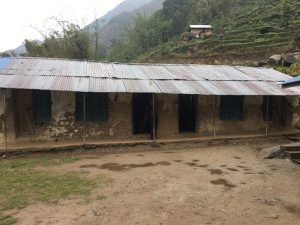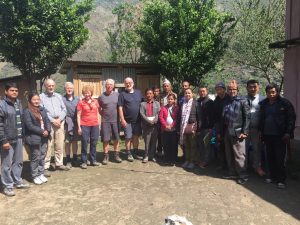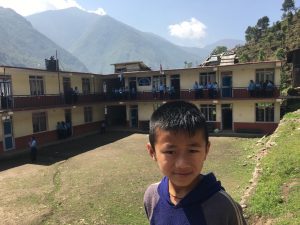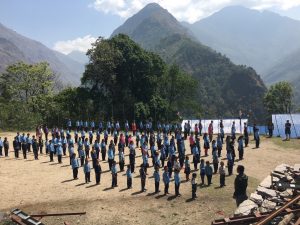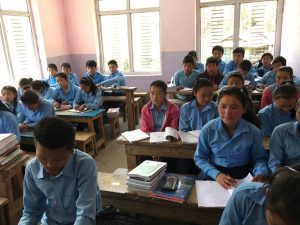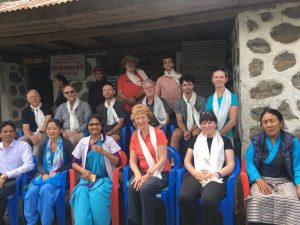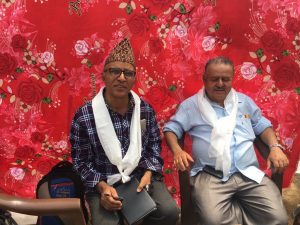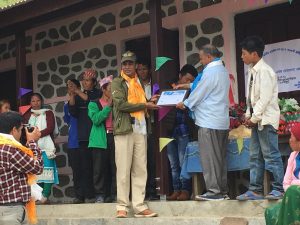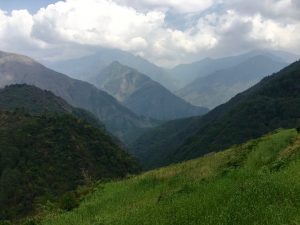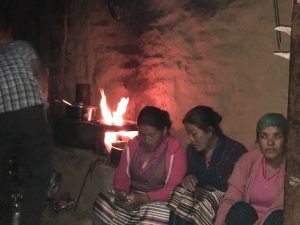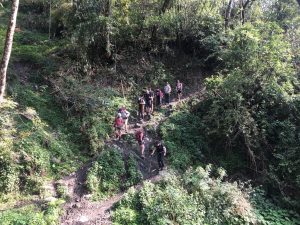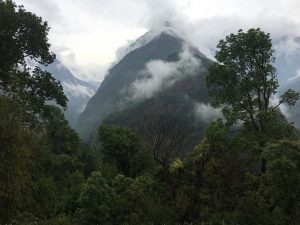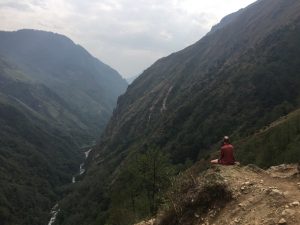We delayed our departure from Taplejung until 10.00am so that we had time, hopefully, to get our washing dry. Unfortunately, the damp atmosphere that prevailed overnight meant that everything was still damp. It was also a good move as it took one and a half hours for breakfast to be served after ordering.
The drive to Tapethok was interesting, to say the least. Up to Suketar the road had a proper surface but beyond that for the next four and a half hours we were subjected to an increasingly bumpy ride as the, jokingly called road, was created more recently. At one point the driver, hardly more than a boy, became concerned about something behind him. He was looking at the rear off-side wheel. He should have been looking at the rear nearside wheel, for when he realised it the wheel was almost off. A little time was wasted while he tightened up the nuts. In places the road was nothing more than a collection of misshapen rocks randomly placed on a steep slope or mud filled ruts. Needless to say the going was slow. Nevertheless, it was beautiful the further we delved into the valley with the raging waters of the Timor River below. As we reached places we knew it was interesting to see where they had taken the road. Thankfully they did not try to take it through the centre of Chiruwa, but beneath it between it and the river. Soon after passing through Chirewa we reached Tapethok where we were to stay for the night. As we did so the rain began to fall. Seven could be accommodated in the lodge while three of us had to camp. We quickly put up the three tents before the heaviest of the rain in the hope that the inners would have an opportunity to dry out.
After a quick noodle soup we headed off to Tapethok School before all the children went home. This is my third visit to this school in as many years and it does not really get any better. The school looks tired, the newer of the two buildings looks as if it will fall down at any minute. There is electricity but only to the office. The classrooms are wired up but there are no bulbs in sockets so ultimately the classrooms are very dark. Not ideal. There seems to be a lack of motivation among the staff, possibly because it was last thing on a Friday, or because there are only five teachers for the eight classes. The headmaster is basically a dull man and he runs a dull school. I think, with an inspirational head, this school could be much better.
 It was good to see the newly installed water supply but much of the conversation we had was about how to provide children with a midday snack. This is becoming a common theme running through our visit. It is something that, I believe, is a major issue and one for which I would like to find a solution, so long as it does not detract from our core work.
It was good to see the newly installed water supply but much of the conversation we had was about how to provide children with a midday snack. This is becoming a common theme running through our visit. It is something that, I believe, is a major issue and one for which I would like to find a solution, so long as it does not detract from our core work.
The meeting over, we had cardamon tea and biscuits after we had been presented with numerous garlands.
That night, while most of the group slept in the lodge, three of us chose to camp and I had a really good, undisturbed night’s sleep.
We woke to clear blue skies and the promise of a lovely day, an opportunity to dry my washing and the tent. Although I succeeded in drying my washing, some of it had been wet for too long and smelt worse than it did before I washed it.
After breakfast Rajendra took Tim, Kate, Mike , Ian and me up to a place in the village where a meeting was to take place with the Chairman of the Rural Municipality. There have been a great many changes in Nepal in recent months, since a majority government was elected and there was a reorganisation of local politics with elected local leaders. No longer are there VDCs (Village Development Committees) but wards. Before we worked in Lelep, Ikhabu, Tapethok, Olangchungola and Yamphudin. They all, with the exception of Yamphudin, fall under the ward known as Phoktanglung. There are three other former VDCs now under the control of this new ward, Sawadin, Lingkhim and Khejinim, which do not benefit from the support of REED or HTUK. There is a plea that we include these three areas into our programme, which would support a further nineteen schools. I think REED, and Rajendra in particular, are under significant political pressure.
The elected chairman of Phoktanglung Rural Municipality is a young, committed politician, eager to make change for the better for all people within his remit. He is a parent at Sundevi School and has seen at first hand the benefits of REED’s intervention. Presumably he has political accountability to the electorate, and, as such, wants equal opportunity for all. This is far more important than devising a way to support a snack fund. HTUK is going to have to look very closely at what it does and how it does it within the serious confines of its financial capability.
One thing that was interesting is that he would be prepared to match fund any donation with governmental funding. I think it is important that the Nepalese Government, even at local level, should be involved in supporting their rural communities in every respect.
This then begs the question, what to do about Yamphudin? It falls under a different rural municipality and is only one of another nine wards, none of which we are working in. We cannot contemplate, from a financial point of view, to support so many more schools, despite pleas from Mamanke and Khewang for our support. Yamphudin, we know has good schools under good leadership. In a few months they will have a new health post. Is now the time to say to Yamphudin that you are well set up to stand on your own two feet?REED can continue to monitor for a period of transition but HTUK be considering moving out of Yamphudin once the work is complete?
It was a very interesting meeting and has given us a lot to think about as we plan our future involvement with the project. We may be forced to move in a direction we were not planning for, although we always knew there was a desire for us to expand.
Returning to our lodge and camp, we then visited the health post in Tapethok. I have always been impressed with this health post as it has always seemed to be efficiently run. The 24 year old nursing auxiliary midwife who showed us around was not only charming but also came across as extremely efficient and capable in her work. The sad thing is, that as a young wife, she has been posted to this remote clinic while she leaves a husband in Kathmandu. While she is excellent, the sooner we can train a local woman who is committed to living in the community, the better.
Meetings over, we set out on the three hour walk to Lelep, initially walking along the side of the Tamor River, before climbing through woodland to the village of Lelep. The village is undergoing change. Many of the fields and terraces seem to be growing cardamon, a cash crop, rather than crops that will sustain the dietary needs of the community. The road will reach Lelep before the end of the year and, I believe, the community are preparing in advance the opportunity to get a cash crop out and the ability to have supplies brought in by road. Whilst it will be great for the community I fear for the environmental impact the road will have and how it will change the nature of these rural communities, not always for the best.
By late afternoon the sunny day had disappeared behind heavy clouds and another thunderstorm brought a soggy and violent end to the day.
I woke early after a good night’s sleep in my tent. It gave me time to have a cold shower and do some washing before the others woke up. Stupidly, I forgot my towel so I air dried while doing my washing.
Gradually, as 10.00am approached children started arriving at the school, intrigued by three tents on their playground.
At 10.00 the oxygen cylinder chimed the start of school and the children lined up on the playground, positioning themselves an arm’s length of each other front and back. A speaker sprang into life and the children sang the Nepali National Anthem. A number of children were then selected to lead the brain gym, also set to music. Brain gym is a series of movements that mark the transition between free play and focused learning. When that was over a couple of older boys were called out to the front to remind us all about the importance of education.
Once assembly was over the children quickly and enthusiastically went to their various classrooms. However, before lessons could start the staff could spend ten minutes in the staff room preparing their lesson. It is worth knowing that, although term has started, the first two weeks are for registration. Not all children will show up and nor will all of the teachers. Hence, two or three classes could be combined until such time as all the teachers are present.
Once the classes were up and running we split up and visited each in turn. We observed an English class, two geometry classes, a social studies class discussing development, a class learning a new class song, a Nepali class and a class of younger children learning their English letter sounds and using them in simple words. Most of the teachers were animated and enthused the children. The children may have been subdued a little by our presence.
Having been round all the classrooms we adjourned to the office for a formal chat. I was able to congratulate the staff on their wonderful new building and that I wished all schools could have such a wonderful asset. All the rooms are light and airy. It was a shame that I was not able to see the electricity working but at least it was not through their fault but that of a transformer in the micro hydro-electric supply. They requested help with science, maths and English and when I asked if they would appreciate volunteers, they affirmed that they would.
I was horrified to learn that the hostel, which houses 30 girls, between the ages of 10 and 16, has no adult supervision beyond the school day. They have a cell phone so they can contact the head or another member of staff in the event of an emergency. They do all their own cooking and washing. I know Nepali children are much more self-sufficient than most western children, but I don’t think this is right.
We had spent a successful morning in the school and I left feeling much more optimistic about the school and the education it was providing.
As I left I caught my head on the bar above the gate, taking off a layer of skin just where I had taken a layer off in Kathmandu a few days previously.
Appropriately we headed over to the health clinic to meet with the staff there. The same young woman that I had met on my two previous visits was still there. She upset me last year by saying that there would be no outcomes from our visit. Well, they got electricity from us last year. Unfortunately, it was also victim of the transformer malfunction. This time she was much more pleasant and is obviously doing a good job for the community. She is in a bizarre situation. Her home is in the Terai where she has a twelve year old son and a husband. She has hardly seen them in the last four years. Her male assistant comes from the far west of Nepal. It seems to be a crazy situation for I understand that there are similarly qualified people from Taplejung who work in other parts of Nepal at the insistence of the government.
We were amazed to hear that the clinic does not have its own water supply but relies on staff carrying buckets of water from the nearest source. When I enquired how much pipe they would need to have their own supply we were told 200m which would cost NRs12,000. That is nothing and I told her I would return after lunch with the money. I wasn’t going to get involved with the details of the concrete stand pipe and all the extras, the community could do that. Even if they don’t, the clinic will still have piped water.
After lunch I returned with the money. While I did that, Mike returned to the school to do some teaching. He thoroughly enjoyed himself and was found to be of interest to the dignitaries, press and TV who arrived en route to the school opening ceremonies due to take place the next day to celebrate the completion of the earthquake rebuild, to which we will also be attending.
For some days I have been gathering a fine collection of insect bites all over my body and legs. I think I have just found the source – ants! Tiny little brown ants. The bites are driving me mad. I would much rather have leeches on me.
In the morning we woke early as we had a busy day celebrating the ‘Build Back Better’ programme after the 2015 earthquake. A number of important big wigs were also staying in the lodge including the Resource Person, the DEO (District Education Officer) and a photographer and camera man from Kantipur, a Kathmandu television station.
We set off after breakfast for the two hour climb up to Lawajin Basic School, a remote community a long way up the hillside. At first we zig-zagged through woodland until we reached the crest of a ridge, giving us exclusive views up the Olongchungola Valley towards the border with Tibet. Had cloud not been hovering at the head of the valley, we would have been able to see white peaks piercing the sky.
The climb continued at a more gentle gradient up to another high point from which we could see the village with the school at its heart. Music could be heard as they made preparation for us. After a lengthy flat section we dropped down to cross a stream by a suspension bridge. On the rise on the other side of the river scouts were waiting to greet us with khata scarves. They then led us towards the school but before we reached it a drummer and cymbalist, along with all the children from the school, came to guide us in. A welcome arch of newly cut foliage lead us on to the playground where a canopy had been erected to protect us from the sun. There was a lot of activity with furniture being placed once, then moved to another place, only to be moved a third time. The new building looked good and houses the office and one classroom. Inside, they are bright and airy with a central skylight that makes all the difference. The walls are painted white with instructive murals painted on them. Mobiles hang from the ceiling.
As we sat under our canopy we were plied with fluid, first a cold orange drink, followed by tea, sickly sweet Red Bull and beer. Fortunately the toilets were not too bad. Behind them was the new water facility, which did not appear to be connected, or, perhaps it had been disconnected temporarily by the group of women busy producing hot water and cooking a lunch for everybody. There was a lone goat tethered there as well and I feared for its well-being a little later in the day.
 Eventually the proceedings started with a quiz for three teams of children, the questions based on their curriculum. There seemed to be very few taking a great deal interest. Afterwards there were all sorts of little acts of ceremony with the DEO cutting a ribbon, me reading out what was on the brass plaque, presentation of certificates to various people involved with the rebuild. There were speeches from the various dignitaries there, including me. I won the prize for the shortest speech while the DEO and the political leader of the ward were quite lengthy. Occasionally dances filled the gaps between speeches, giving the whole occasion an air of chaos and confusion, added to by the occasional malfunction of the sound system.
Eventually the proceedings started with a quiz for three teams of children, the questions based on their curriculum. There seemed to be very few taking a great deal interest. Afterwards there were all sorts of little acts of ceremony with the DEO cutting a ribbon, me reading out what was on the brass plaque, presentation of certificates to various people involved with the rebuild. There were speeches from the various dignitaries there, including me. I won the prize for the shortest speech while the DEO and the political leader of the ward were quite lengthy. Occasionally dances filled the gaps between speeches, giving the whole occasion an air of chaos and confusion, added to by the occasional malfunction of the sound system.
After all the speeches and ceremony we were served a lunch of rice, dal and cauliflower. There was some fish on some plates, not mine, but as it was nearly all bone and no meat I did not mind. I also avoided the goat that was available.
During lunch one of the villagers came up to me to thank the Himalayan Trust. His son had received a scholarship from us and has now just graduated as a CMA (Community Medical Assistant). He was so very grateful to us for giving his son this opportunity and start in life.
After a bit more dancing, with audience participation, we were escorted down the path by the same drummer and cymbalist that greeted us.
We were heading towards Lungthung School, another victim of the 2015 earthquake. I had visited it in 2016 and was shocked by the extent of the damage. It was a lovely walk through a mixture of woodland and terracing. Until we dropped over a ridge that brought Lungthung into view, we had been able to hear the continuing party at Lawajin.
When we arrived there were many parents gathered on the playground waiting for something to happen. The children were still in class so we took the opportunity to see the new classrooms with children in them. They had been built to the same design as at Lawajin but there were six new classrooms. It was good to see both children and teachers enjoying this new facility.
 After the tour, we went to sit on the playground where tables and chairs had been placed for us so that we could join the many parents. It was beginning to rain lightly as the headmaster started the proceedings, which followed a similar pattern to the morning session with lots of introductions and speeches. The head who was leading the programme didn’t altogether seem to know what was happening and kept referring to Rajendra for guidance. I was pleased that we were not being subjected to microphones being wired through karaoke machines. There was similarly a little dancing.
After the tour, we went to sit on the playground where tables and chairs had been placed for us so that we could join the many parents. It was beginning to rain lightly as the headmaster started the proceedings, which followed a similar pattern to the morning session with lots of introductions and speeches. The head who was leading the programme didn’t altogether seem to know what was happening and kept referring to Rajendra for guidance. I was pleased that we were not being subjected to microphones being wired through karaoke machines. There was similarly a little dancing.
When it was all over a meal was served of flaked rice with goat. There had been no carving of meat but a hacking of the whole animal into small bits that included a lot of offal, splinters of bone and, on Harry’s plate, a tooth. Harry is vegetarian.
Again, I avoided the meat.
We were supposed to camp on the playground but it wasn’t really very suitable as it was stony on loose soil. Instead, we stayed in two houses close the the school, the families sacrificing their bedrooms for us. I think my room belonged to the daughter of the house.
We spent the evening in the kitchen of one of the houses having fun with the family. You don’t get experiences like that on a normal trek.
That night it rained heavily so we were glad not to be camping.
The following morning there were snowy peaks showing at the head of the Olangchungola Valley. After breakfast we walked back to Lelep in time for an early lunch, before heading across to two schools in the Hellok Valley. I decided not to go as I was having a bit of pain from my Achilles, but was more concerned about a bit of chaffage. It was only when I went to wash that I realised the extent of it, it having turned a bit nasty. Hopefully, plenty of cream will enable me to walk comfortably to Amjilosa tomorrow.
I’ve now got a cold! As I dressed and packed this morning and took down my tent I was sweating profusely and as I took my kit over to the lodge, I moved lethargically. I took a couple of paracetamol and hoped that I could cope with today’s walk from Lelep to Amjilosa, which included a steep climb at the end.
I started quite well, the paracetamol having taken effect. I set the pace which suited me and knew would benefit the majority of the group. Jonathan is supremely fit and likes to race on ahead occasionally. The route up the valley towards Ghunsa is not easy. It is very undulating, crosses some difficult terrain where landslides had occurred during and since the earthquake. The noise from the river was deafening as the torrent raced and tumbled over a chaotic array of rocks, some the size of a house. It really was spectacular.
After a couple of hours I began to flag and questioned my ability to reach Amjilosa. I had absolutely no strength in my thighs. What made it so difficult was the fact that I could not find a rhythm; there were a lot of ups and downs and every footfall had to be planned. I was breathing heavily and sweating so much it poured off the end of my nose. I decided at the next stop I would take two more paracetamol. Kate also distributed some of the contents of my rucksack among other members of the group.
We eventually reached the last settlement in the valley bottom before embarking on the climb up to Amjilosa. I drank a bottle of coke, tea, with sugar, water and noodle soup. After at least an hour’s rest we set off, crossing the river for a fourth and final time. I felt so much better following my sugary intake. Because it was steep I could find a rthythm, control my breathing and my temperature. I led most of the way up the zig-zag path. Amjilosa came into view and we were there. I did not think I would have reached it a few hours earlier. Now I have to psych myself up again for tomorrow’s challenging walk to Gyabla.
I lost my appetite in the evening. Dal bhat did not appeal to me one little bit. I hoped this was not a bad omen!
It was! In the early hours of the morning I had to make a dash for the toilet and again as the dawn light lit up the snowy peaks at the head of the valley. It did not take me long to decide not to go any further but to head back down to Lelep. At least there I can rest and I can spend a couple of days observing lessons in the school. So, while the rest of the group headed up towards Gyabla, I headed back down with my porter.
By the time I reached Lelep and the final climb up to the lodge I was at the limits of my endurance. I could not go another step. That feeling confirmed that I had made the right decision, along with the fact that I still had an upset stomach. Hopefully four days of not doing very much will see me right for the last phase of this trip.
I spent over twelve hours in bed last night, mostly asleep but punctuated with visits to the toilet. I ate nothing in the morning, spending my time between reading and dozing. Premina persuaded me to have some noodle soup for lunch but within three hours that had passed through me. I have no energy and am beginning to wonder if I will be strong enough for the rigours of the next few days after the rest of the group return from Ghunsa.
It took at least 48 hours for the medicine from Lelep health post to kick in and for me to begin to feel as if I might be able to continue with this journey rather than return to Kathmandu early. One of the benefits is that I seem to have lost a significant amount of weight. My shorts no longer fit me snuggly! A great result but I would have preferred to have achieved it by normal means.
On my last lonely morning the whole village emptied. Roadworks have come to a standstill. Whilst the villagers want the road they do not want to lose any land to it. The road has reached a point where the landowner is adamant that it is not crossing his land. There is no compensation for loss of land or potential loss of income, so he is digging his heals in. The conversation started early this morning outside my lodge before moving on to the point where the work has come to a standstill. There was an eerie silence in Lelep. And when the people did return, nothing had been resolved. Stalemate, for the time being at least.
Early in the afternoon the group returned from their journey to Ghunsa. It was good to see them and to have some good humoured company. They had found the trek demanding and were ready for the opportunity to shower, wash some kit and to flop. Fortunately for them the next day, 1st May, was a rest day before the final phase of the trip, which would eventually see up back in Taplejung having visited a further eight schools.

